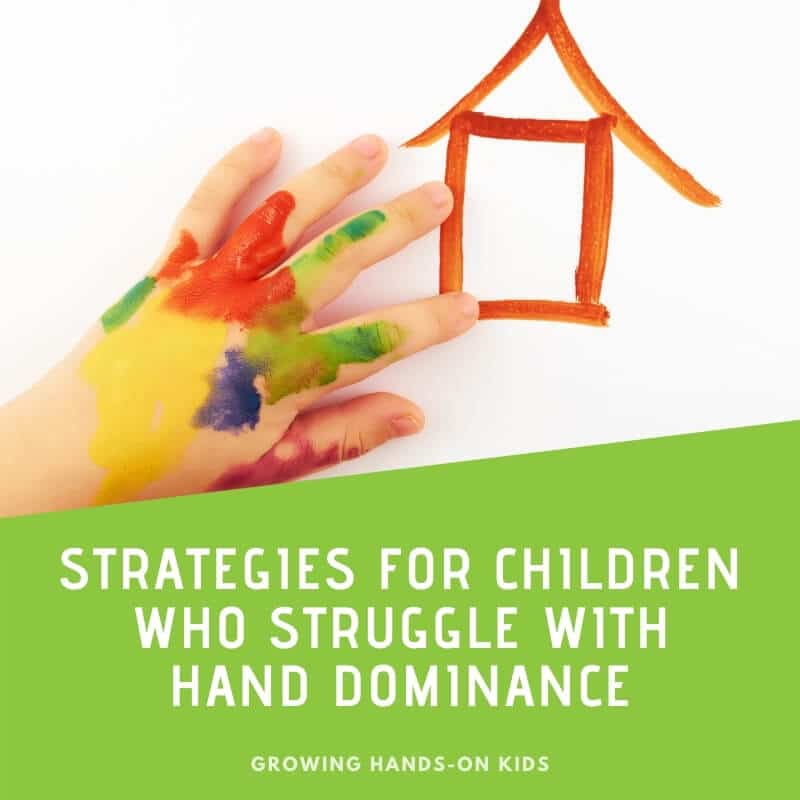Strategies for Children Who Struggle with Hand Dominance
Affiliate and Referral links are used below to promote products I love and recommend. I receive a commission on any purchases made through these links. Please see my disclosure policy for more details. As an Amazon Associate, I earn from qualifying purchases.
Last time we talked about the development of hand dominance in children. So now that we understand that, let's talk about some strategies for helping children who struggle with hand dominance.
Hand Dominance Struggles
In the last post, we looked at what the typical development of hand dominance looks like. Based on the research, we found that hand dominance starts to develop before a child is born. By age 6, most children should have finalized which hand they are consistently using for tasks, whether that be the left or right hand.
So what do struggles with hand dominance look like?
- Your child may switch hands during fine motor activities such as handwriting or using scissors (they may start with their right and then switch to their left mid-activity and visa versa).
- May complain of their hand getting tired during fine motor activities.
- May try to avoid fine motor activities all together
Strategies to Address Hand Dominance Struggles
These first three tips will apply to any child, not just those who struggle with hand dominance.
#1 – Observe, Observe, Observe
The first tip, do nothing but observe. I know you may want to jump right in and help, but sit back and observe your child using their hands. Do they always start with the same hand and then switch mid activity? Are they picking a different side each time they do an activity? Are there certain activities they always pick one side over the other?
#2 – Place items or toys at the child's midline, not on their right or left
Placing items in the neutral midline (directly at the middle of their body) allows your child to choose which hand to pick the item up with. If you place an item on your child's left or right side, they are more likely to use the side closest to the item.
While this may not seem like a big deal, if your child is still in the process of developing hand dominance, this allows them to develop consistency when choosing which hand to use without an adult choosing the side for them.
#3 – Do not force your child to use one side vs. the other (right or left)
This is something I did all the time when working with children in school. If they choose the right (or left) hand to use with scissors, then that is the hand they need to stick with for the completion of that activity. If they choose a different side the next time they cut with scissors, that is fine, they just need to finish the activity with the same hand.
Do not force them to pick a certain side (see tip #2 placing items at their midline). But once they do pick a side, they need to finish the activity with that side. If they try to switch sides, encourage them to use the same side they started with.
#4 – Work on crossing midline
Many children who are swapping hands during an activity can struggle with crossing midline. Crossing midline is the skill needed for many fine motor activities that allow your child to use one side with the non-dominant hand supports.
Children who struggle with crossing midline will often swap hands when the activity moves from the right to the left side (and visa versa). You will see this a lot with cutting and handwriting activities.
For some fun crossing midline activities, check out these posts below.
- Crossing Midline Activities for Kids
- Crossing Midline Exercises for Kids
- Crossing Midline Activities for Toddlers
#5 – Focus on bilateral coordination skills
Bilateral coordination is important for hand dominance since it is using both sides fo the body together (one dominant side and one support side). This boils down to the brain being able to pick a dominant side to perfect and master skills and the non-dominant side being able to support. This is especially needed for scissor and handwriting tasks, but also gross motor skills like catching a ball or holding a cup for everyday life skills.
You can find bilateral coordination activity ideas here.
#6 – Work on hand strengthening activities
Some child may lack hand strength in their dominant side and this is what causes them to switch hands during activities.
Work on hand strengthening activities to help increase hand strength.
Click here for more ideas for hand strengthening activities.
Need more ideas and suggestions? Check out my resources below.
- Typical Fine Motor Development for Children Ages 0-6
- What Fine Motor Skills Are Important for Handwriting?
- Fine Motor Activity Ideas for Ages 2-4
- Typical Visual-Motor Development for Children

Heather Greutman, COTA
Heather Greutman is a Certified Occupational Therapy Assistant with experience in school-based OT services for preschool through high school. She uses her background to share child development tips, tools, and strategies for parents, educators, and therapists. She is the author of many ebooks including The Basics of Fine Motor Skills, and Basics of Pre-Writing Skills, and co-author of Sensory Processing Explained: A Handbook for Parents and Educators.





haii i’am occupational therapist in indonesia. I just finished college and I’ve been working for four months in pediatrics. Iam very grateful because i find your website. Your article very informative, detail and usefull for me, now i have new knowledge!! i hope you always healthy and God Bless You😇